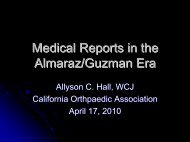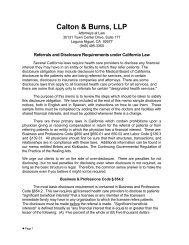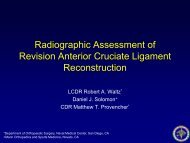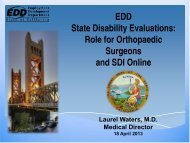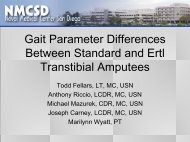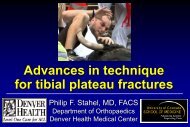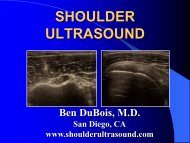Enhancing Your Practice's Revenue - California Orthopaedic ...
Enhancing Your Practice's Revenue - California Orthopaedic ...
Enhancing Your Practice's Revenue - California Orthopaedic ...
- No tags were found...
You also want an ePaper? Increase the reach of your titles
YUMPU automatically turns print PDFs into web optimized ePapers that Google loves.
Appendix:Ten Top TipsBy Steven E. Fisher, MBAThe preceding chapters outline twelve different strategiesfor generating additional income. This appendix containsgeneral information relating to the strategies. Some of thetips will help you make good decisions regarding which ofthem might make sense for you to pursue. Others provideguidance that will ensure that the ventures you ultimatelydo pursue are financially and operationally successful.1. Financial Statements and BudgetsMany authors made reference to financial statements and/or budgets. It is of crucial importance for the owner(s)of any business to understand how their business isperforming from a financial standpoint. This involves,at a minimum, learning about the three major financialstatements: the Profit and Loss (P&L), the BalanceSheet, and the Statement of Sources and Uses of Cash. Inaddition, owners need to understand what is involved indeveloping capital and operating budgets every year andcomparing actual results against budgets. This is a toolthat allows business owners and administrators to identifyproblems before they become serious. Examples of financialstatements are available on the AAOS on-line PracticeManagement Center. For more information, see (www.aaos.org/pracman). See also # 10 below.2. Formulas for Calculating Investment ReturnThere are many formulas for calculating returns butfollowing are three in common use:• Net Present Value (NPV) is the difference between theamount of the up-front investment required to starta business venture and the discounted value of thefuture cash flows. The NPV will vary depending on thediscount percentage used, and different practices will usedifferent percentages.• Return on Investment (ROI) measures the efficiency ofan investment. It is a ratio whose numerator is “Gainfrom Investment minus Cost of Investment” and whosedenominator is “Cost of Investment.” It does not takeinto account the time value of money.• Payback is the length of time that it takes for a projectto recoup its initial cost out of the cash receipts that itgenerates. The premise of the payback method is that themore quickly the cost of an investment can be recovered,the more desirable is the investment. Like ROI, it doesnot take into account any discount rate.Many financial analysts argue that NPV is the mostsophisticated measure of the three described above.However, investors’ access to capital is limited; thereforeit is likely that they will be obligated to choose betweenalternative investments vehicles even if all of them havepositive discounted cash flows. Investors in any businessneed to discuss alternative formulas for calculatinginvestment return and come to closure regarding whichformula they will utilize.3. Governance vs. ManagementGovernance and management are not identical andconfusing the two will can result in operational problems.Governance is something that the owners of a businessventure must do. Among other things it involves (a)making strategic decisions regarding the mission andgoals of the enterprise; (b) executing agreements thatallow the business to commence operation and remain inbusiness; and (c) formulating short and long term plans.Management by contrast involves oversight of day-to-dayoperations. Day-to-day operations include finance andaccounting, human resources management, oversight ofclinical operations, regulatory compliance, informationtechnology, and marketing. In some cases, one of thedoctors may function as the senior manager; in most cases,however, it is wise to recruit and employ someone who hasbusiness-related education and experience. See #4 below.4. Critical Need to EmployHigh-quality ManagementHistorically, it was often true in solo offices that the spouseof the orthopaedist functioned as the office manager. Thesedays, however, it takes a great deal of knowledge and skillto run even a small practice. To the extent that physiciansdecide to embark on any of the activities described inthe Primer, they should seriously consider recruiting andemploying a professional manager, someone who hasknowledge and skills in areas such as (a) negotiating withpayors; (b) hiring, training, evaluating and terminatingstaff; and (c) developing policies and procedures to ensurepractice compliance with government regulations such asStark, Anti-kickback and HIPAA.5. Lease vs. Buy AnalysesIf an orthopaedic practice plans to pursue many of theincome generation strategies outlined in the Primer, itwill be necessary to acquire equipment. The questionarises as to whether leasing or buying is the better option.The decision is not always an easy one to make becausethe two acquisition options both have advantages anddisadvantages. For example, leasing generally requiresminimal down payment (or none); it may protect thepractice against obsolescence; and payment may be spreadover a longer period of time. Purchasing may provide taxadvantages, and the monthly costs may be lower but it44© 2011 American Academy of <strong>Orthopaedic</strong> Surgeons




